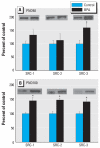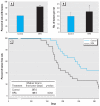In utero exposure to bisphenol A shifts the window of susceptibility for mammary carcinogenesis in the rat
- PMID: 20675265
- PMCID: PMC2974702
- DOI: 10.1289/ehp.1002148
In utero exposure to bisphenol A shifts the window of susceptibility for mammary carcinogenesis in the rat
Abstract
Background: Bisphenol A (BPA) is a ubiquitous environmental chemical with reported endocrine-disrupting properties.
Objective: Our goal in this study was to determine whether prenatal exposure to BPA predisposes the adult rat mammary gland to carcinogenesis.
Methods: Pregnant rats were treated orally with 0, 25, or 250 microg BPA/kg body weight (BW) from gestation day (GD) 10 to GD21. For tumorigenesis experiments, prenatally exposed female offspring received a single gavage of 7,12-dimethylbenz(a)anthracene (DMBA; 30 mg/kg BW) on postnatal day (PND) 50, or PND100.
Results: Prenatal exposure of the dam to 250 microg BPA/kg BW combined with a single exposure of female offspring to DMBA on PND100, but not on PND50, significantly increased tumor incidence while decreasing tumor latency compared with the control group. Prenatal exposure of the dam to 250 microg BPA/kg BW, in the absence of DMBA to the female offspring, increased cell proliferation and elicited differential effects at the protein level at PND100 compared with PND50. Differentially regulated proteins in the mammary gland included estrogen receptor-alpha, progesterone receptor-A, Bcl-2, steroid receptor coactivators, epidermal growth factor receptor, phospho-insulinlike growth factor 1 receptor, and phospho-Raf.
Conclusions: Our study demonstrates that oral prenatal exposure to BPA increases mammary cancer susceptibility in offspring and shifts the window of susceptibility for DMBA-induced tumorigenesis in the rat mammary gland from PND50 to PND100. These changes are accompanied by differential effects of prenatal BPA exposure on the expression of key proteins involved in cell proliferation.
Figures





Comment in
-
Opening the window to cancer. Potential mechanism behind increased susceptibility in rats exposed prenatally to BPA.Environ Health Perspect. 2010 Nov;118(11):A490. doi: 10.1289/ehp.118-a490b. Environ Health Perspect. 2010. PMID: 21465746 Free PMC article. No abstract available.
Similar articles
-
Perinatally administered bisphenol a as a potential mammary gland carcinogen in rats.Environ Health Perspect. 2013 Sep;121(9):1040-6. doi: 10.1289/ehp.1306734. Epub 2013 Jul 23. Environ Health Perspect. 2013. PMID: 23876597 Free PMC article.
-
Impact of gestational low protein diet and postnatal bisphenol A exposure on chemically induced mammary carcinogenesis in female offspring rats.Environ Toxicol. 2019 Nov;34(11):1263-1272. doi: 10.1002/tox.22827. Epub 2019 Jul 9. Environ Toxicol. 2019. PMID: 31287222
-
Oral exposure to bisphenol a increases dimethylbenzanthracene-induced mammary cancer in rats.Environ Health Perspect. 2009 Jun;117(6):910-5. doi: 10.1289/ehp.11751. Epub 2009 Jan 7. Environ Health Perspect. 2009. PMID: 19590682 Free PMC article.
-
Effects of developmental exposure to bisphenol A on brain and behavior in mice.Environ Res. 2008 Oct;108(2):150-7. doi: 10.1016/j.envres.2008.07.023. Environ Res. 2008. PMID: 18949834 Review.
-
Estrogens in the wrong place at the wrong time: Fetal BPA exposure and mammary cancer.Reprod Toxicol. 2015 Jul;54:58-65. doi: 10.1016/j.reprotox.2014.09.012. Epub 2014 Sep 30. Reprod Toxicol. 2015. PMID: 25277313 Free PMC article. Review.
Cited by
-
Hormone-Like Effects of Bisphenol A on p53 and Estrogen Receptor Alpha in Breast Cancer Cells.Biores Open Access. 2019 Oct 31;8(1):169-184. doi: 10.1089/biores.2018.0048. eCollection 2019. Biores Open Access. 2019. PMID: 31681507 Free PMC article.
-
Perinatal Exposure to Bisphenol A or Diethylstilbestrol Increases the Susceptibility to Develop Mammary Gland Lesions After Estrogen Replacement Therapy in Middle-Aged Rats.Horm Cancer. 2017 Apr;8(2):78-89. doi: 10.1007/s12672-016-0282-1. Epub 2017 Jan 11. Horm Cancer. 2017. PMID: 28078498 Free PMC article.
-
Prenatal exposure to BPA alters the epigenome of the rat mammary gland and increases the propensity to neoplastic development.PLoS One. 2014 Jul 2;9(7):e99800. doi: 10.1371/journal.pone.0099800. eCollection 2014. PLoS One. 2014. PMID: 24988533 Free PMC article.
-
Epigenetics meets endocrinology.J Mol Endocrinol. 2011 Feb;46(1):R11-32. doi: 10.1677/jme-10-0053. J Mol Endocrinol. 2011. PMID: 21322125 Free PMC article.
-
A review of the carcinogenic potential of bisphenol A.Reprod Toxicol. 2016 Jan;59:167-82. doi: 10.1016/j.reprotox.2015.09.006. Epub 2015 Oct 19. Reprod Toxicol. 2016. PMID: 26493093 Free PMC article. Review.
References
-
- Baylin SB, Herman JG, Graff JR, Vertino PM, Issa JP. Alterations in DNA methylation: a fundamental aspect of neoplasia. Adv Cancer Res. 1998;72:141–196. - PubMed
-
- Betancourt AM, Mobley JA, Russo J, Lamartiniere CA. Proteomic analysis in mammary glands of rat offspring exposed in utero to bisphenol A. J Proteomics. 2010;73(6):1241–1253. - PubMed
-
- Biles JE, McNeal TP, Begley TH. Determination of bisphenol A migrating from epoxy can coatings to infant formula liquid concentrates. J Agric Food Chem. 1997;45:4697–4700.
-
- Bouras T, Southey MC, Venter DJ. Overexpression of the steroid receptor coactivator AIB1 in breast cancer correlates with the absence of estrogen and progesterone receptors and positivity for p53 and HER2/neu. Cancer Res. 2001;61(3):903–907. - PubMed
-
- Bradley CJ, Kledzik GS, Meites J. Prolactin and estrogen dependency of rat mammary cancers at early and late stages of development. Cancer Res. 1976;36:319–324. - PubMed
Publication types
MeSH terms
Substances
Grants and funding
LinkOut - more resources
Full Text Sources
Medical
Research Materials
Miscellaneous

